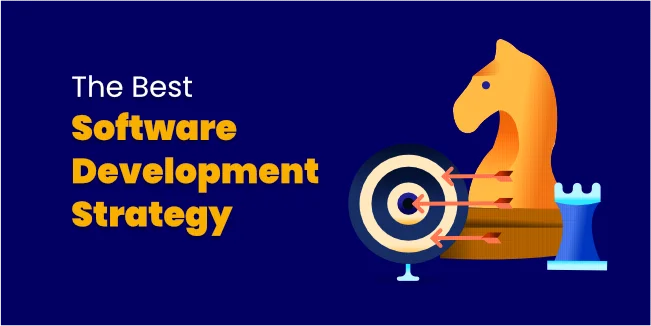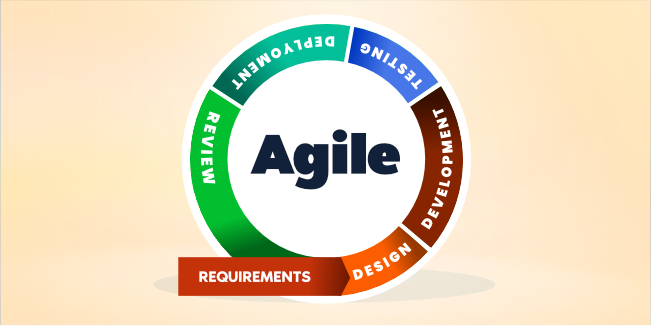development
Process
company
strategy
The Best Software Development Strategy

The last ten years have seen most software development methods reliant on piecemeal action, with firms having difficulty delivering effective answers.
The term "software development strategy" is often used in software engineering, although it has no concrete meaning. It refers to a collection of decisions made during the software development process. As a result, the chosen software development method will determine how committed developers are to designing, developing, and releasing projects.
In this post, we'll go over some of the most prevalent software development ideas. We'll also discuss factors influencing determining which software development strategy is best for your company.
Software Development Process
It is clear that the software development process has no single standard. As a result, it may be tailored to the needs of various software development projects. Fortunately, experts credited relevant techniques for influencing the formation of a typical software development process as part of the Agile scrum revolution.
Essentially, today's software development firms appear to value Agile and Scrum methods in terms of saving time and money. Consequently, whenever they're building a project, they come up with the idea of following set standards for beginners.
Vendor Research
Each software development company would specialize in a select group of current technology. Concentrating on technological innovation allows the specialized software development team to optimize their time and skill. Furthermore, focusing on innovative software development is popular among outsourcing businesses because they may utilize standard code and resources.
Most software developers can produce both mobile apps and web applications in practice. They restrict their experience in some sectors to guarantee a deep understanding of their clients' needs.
At this stage, you must be able to identify a suitable vendor with technology and experience that match your project's needs. As a result, assign a product owner who will be responsible for the final decisions. Furthermore, when selecting software development vendors, you should think about how your product will be used in the future.
Define a Vision

With support from the team, your product owners need to clear three highlights.
First, the main question is, why do you need the software? Is there any problem you can't solve, and a high-quality software like this would make it easier? Or maybe someone has come to you many times with some task, and you want your knowledge to be available to more people. You have to answer this question honestly because that is the essence of the importance of your software.
The next thing to remember is to know how it helps your business grow. It thoroughly studies technical and business factors influencing your software development project outcome. It confirms that the program is useful and makes sense to exist. It can help you find the specific niche in which this application will end up.
The next big aspect of your software product development strategy is to know your project's vision for recent times and beyond. The end of the project development process is not the end of work on it. Maintenance and responding to feedback are permanent features when releasing something to a large number of users.
Project vision consideration might not be an easy task; that needs a typical understanding of coding and project management. In this case, you might need a consultant from your software development vendor.
Considering Integration
We live in a world of connection, and the internet of things (IoT) is becoming more widespread. You will be falling behind if you create a system on your own that cannot interact with other existing programs. Product owners risk failure when they develop a single system without integrating it with other systems.
In this situation, the software would be isolated and run following its expectations owing to the large number of ancillaries required in its ecosystem. We live in a world of connectivity, but the internet of things (IoT) continues to grow more popular. You'll be behind if you create a system on your own that isn't connected to other current software. The failure of a single system to synchronize with other systems may result in the loss of product owners. Because the software's ecosystem demands so many ancillaries, it would be isolated and run according to its expectations due to the high number of ancillaries required.
In today's software development methods, developers value using open APIs, which is a middleman for connecting several systems and sharing a common resource library.
In this phase, product owners must document the discussions during the current implementation and product development processes. Consequently, they will choose how to go and what will be included in the product development process.
Checking Reusable Tools
After completing the previous tasks or solving any difficulties that may have occurred during the preceding steps, you'll want to evaluate your existing inventory and resources. Suppose you engage a competent vendor with prior experience on similar projects. In that case, they will apply the abovementioned activities to your initiatives to save time and money. Reusable tools are also thought not to take bugs or lag. Furthermore, it might speed up testing.
Finalizing
The four stages above should provide enough information before any development activity has been undertaken. As a result, you have papers describing what you need before this time. Currently, you have in terms of the potential development of your software solutions. As a consequence, right now is when you must make clear a list of activities. You should ensure that what should be done first and what must follow later are noted accurately.
Clients frequently divided their tasks into small parts to achieve an MVP. Then, depending on client comments, a better version will be created. This technique is becoming increasingly popular since it reduces the time required to bring a product to market.
Documents Gathering
You can complete the software development methods that would be ideal once you've completed a thorough checklist for the next project. Basically, strategy decisions will be made based on project size and scope. The software development team frequently delivers an MVP with three screens initially.
Software Development Strategies
Businesses need quality software development services. But the time constraint pulls them back from building a digital product that will stun their users and generate revenue. However, several businesses have been able to score both - quality software and lower time to market. It has been possible by putting various strategies and software development practices.
Here are the most used and best-rated strategies to get the most out of your software development methodology.
Defining The Software Scope
The software scope is one of the most crucial aspects of software development. It should be completed early on to prevent any accidental or misunderstood modifications. It also helps everyone stay aligned and on the same page.
The whole product development process is divided into two parts: Scope and Process. The scope of this document pertains to the overall software development process, which includes main program ideas, features/functionalities, deliverables, timelines, milestones, documentation, budget, responsibilities, and other elements. It will also have the approach you intend to use throughout the project's progress. Whether you go with Agile methodology, waterfall method, Kanban, or any other methodology, ensure it's included in the scope.
You may not only improve quality while developing software with a well-defined scope, but you can also speed up the whole process.
You'll need a sturdy framework for your program. Before starting your project, ensure the software's scope specifies the infrastructure, methodologies, technologies, and other things.
Agile Approach

How you work and the approach by which you develop your software will significantly influence how quickly it is completed. It influences the development process, collaboration style, and software offering method.
Agile software development is an effective technique for producing high-quality applications. Agile is recognized for its emphasis on rapidity and efficiency.
Agile, according to this definition, implies a development that is iterative and continuous, with delivery periods of several weeks every few weeks. It adheres to the principles outlined in the Agile manifesto. The following are the stages of an Agile project:
- Creating a software development roadmap and carrying out the project planning
- Breaking down the project into smaller segments and anticipating their release as an MVP
- Each member of the software development team and their deliverables should be planned in a sprint
- To analyze progress and remove bottlenecks, hold hourly scrum meetings daily
- Creating and demonstrating the prototype with the initial capabilities
- During the sprint, I held a meeting with QA and the testing team to review the sprint and test it on beta users
- Holding discussion meetings with the product owner, development team, scrum master, and other team members
Agile development, like conventional technique, requires a team of people with varying skill levels and expertise. What distinguishes it from the traditional approach is the deliverables and timelines.
The entire process is divided into several sprints. These timeframes are usually two to four weeks long. You can evaluate the progress after two weeks, offer your comments, and the team will continue iteratively to incorporate them. Every iteration improves on what came before it.
What is the best way to create software fast and with high quality? There are various causes for this.
One reason is that it allows for rapid change management. You may develop the next version based on the comments received and release it in installments.
Two, Agile minimizes the rework necessary if the software quality or deliverable isn't up to par. Unlike waterfall, all the work put into delivering the ultimate product at completion is not wasted. You must repeat 2-4 weeks' worth of work if the rework is required.
Three, many organizations have proven that you can achieve technical excellence with Agile. In Agile, you'll generally get superior results than previous iterations. It encourages higher standards for the quality of codes, error-free functionality, and other factors.
It is why over half of the firms, such as Apple, IBM, Cisco, and others, are utilizing Agile development.
Organization of Priorities
Every day, there are new developments in the software world. Whether it's a new technology introduction, a version of an established framework, or even the creation of fresh development tools, you'll always discover something new and better to include in your program. Many firms succumb to FOMO and shift their strategy in response to new technological advances.
It will also severely disrupt the progress of your software development team's productivity, however. However, businesses are unable to entirely abandon improvements in their development. It is where it comes in handy.
It would be best if you began prioritizing critical activities over recent changes. However, this should not be at the expense of your overall objective. Anything new might be a blip on the radar for your software, which could cause it to stagnate or even stall.
In fact, it need not be brand new; a stakeholder's whim, an issue that has recently arisen, or a burning tech problem are all possibilities.
It would help if you also distinguished between what is merely referred to as "recently urgent" and what is essential for complete growth.
It is where you take a look at the software's scope. Suppose a change is required because it's critical to satisfying immediate user desires. In that case, you may schedule it for the following sprint. Make sure that the change isn't minor.
Trust in Outsourcing

Nothing compares to the speed and quality that can be achieved by outsourcing software development. Since the 80s, tech leaders like IBM have used this method to fill their technological gaps.
When you hire an offshore development firm to complete your project, you obtain the knowledge and experience of a seasoned business that has completed many similar jobs. They bring years of expertise in managing projects, speeding up procedures, and improving workflows with them. Not only that, but they know how to overcome problems that may arise during the project.
Offshore outsourcing firms have a thorough procedure for quality control, ensuring that the codes they generate are free of bugs and operate correctly. Furthermore, they employ project managers who keep track of projects and meet deadlines.
Companies like mDevelopers are not bothered by other internal distractions or business-related requirements. We can focus solely on high-quality software development while you take care of other core business competencies.
To summarize, you may save time and obtain great software by outsourcing your software development needs to an offshore IT company. You have to be meticulous in your selection of a software development partner.
DevOps Culture
DevOps is a term for development and operations that refers to the communication between the two teams. DevOps integration involves unifying the two teams and maintaining constant procedures to improve quality and speed.
The following operating system is popular in the IT industry for improving software development quality.
DevOps transformation, in fact, does not entail the adoption of a new tool or an alternate SDLC approach. It's a cultural shift that you implement in your business to enhance the quality of your software and speed up its development. You combine people, processes, and technologies to create value through change by deconstructing the insular construction of development and operations.
Businesses that use DevOps also embrace Agile and lean methods in their software development process, which, in turn, enhance productivity and the pace of development.
Tips For Quality Software Development
You may implement those types of strategic moves within your development process to improve the quality and speed of your development. Those, however, are not all. There are numerous simple and minor measures you can take to enhance the overall process while improving the final software's quality.
You can use a few methods to reduce software development time while ensuring quality. You may follow the abovementioned strategies and suggestions to accelerate software creation while maintaining quality.
Priority to Product Features - Every product owner wants to add new features to their program. They want it to address a variety of issues. However, attempting to incorporate all of those features into the software might be a recipe for disaster. The ideal method to get things done is to base your software's features on immediate user needs.
Plan Course Correction For Mistakes - There will be blunders when you start working on your software development project. However, having a strategy for course correction in the event of errors can assist you in standing tall. It would imply that you must be able to anticipate all anticipated issues before they arise.
Use Automation - The pandemic compelled people to live at home. Many firms gave automation a chance to maintain business continuity. And while this may seem like an undesirable trend, it is not expected to reverse anytime soon. It may be used for code testing and improvement.
Trust in Modern Methods - When it comes to speeding up software development, there are many tools on the market. You may use remote working technologies, project management systems, and other AI/ML-powered solutions to automate your operations. GitHub, StackOverflow, Zoho Creators, GitLab, Slack, Monday, and Jira are just a few tools you can utilize. Several additional cutting-edge apps are available to help you get things done faster.
MVP, Then Rest - While features are prioritized, MVP creation employs the method of launching a lesser yet valuable and useful version of the product first before proceeding with iterations. Apart from being faster and cheaper, there are several other advantages to MVP development for startups, including testing the user experience, analyzing market demand for the product, verifying and validating your monetization strategy, and updating your product based on user feedback.
Conclusion
Forward-thinking has sought methods to improve software quality and develop it more quickly. And iterating swiftly and releasing faster may be the key to both of these objectives.
Businesses that want to improve their performance can start seeing the desired effects by adopting methods like outsourcing, taking an Agile approach, establishing clear software scope, ranking essential activities, and embracing a DevOps culture. These techniques can also assist them in gaining a competitive edge and effectively fulfilling the market's demands.